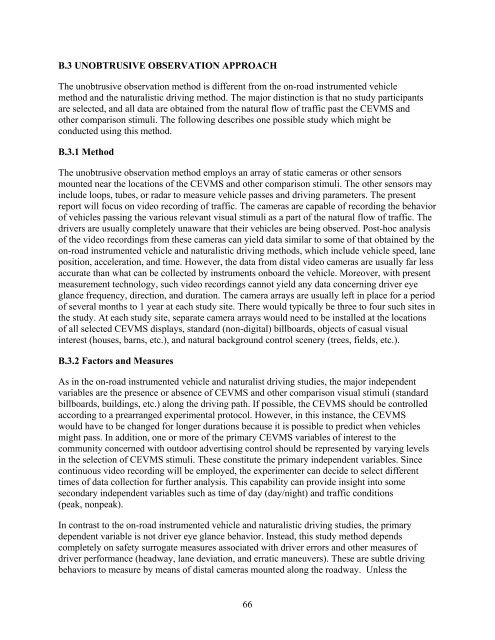The Effects of Commercial Electronic Variable Message Signs ...
The Effects of Commercial Electronic Variable Message Signs ...
The Effects of Commercial Electronic Variable Message Signs ...
Create successful ePaper yourself
Turn your PDF publications into a flip-book with our unique Google optimized e-Paper software.
B.3 UNOBTRUSIVE OBSERVATION APPROACH<br />
<strong>The</strong> unobtrusive observation method is different from the on-road instrumented vehicle<br />
method and the naturalistic driving method. <strong>The</strong> major distinction is that no study participants<br />
are selected, and all data are obtained from the natural flow <strong>of</strong> traffic past the CEVMS and<br />
other comparison stimuli. <strong>The</strong> following describes one possible study which might be<br />
conducted using this method.<br />
B.3.1 Method<br />
<strong>The</strong> unobtrusive observation method employs an array <strong>of</strong> static cameras or other sensors<br />
mounted near the locations <strong>of</strong> the CEVMS and other comparison stimuli. <strong>The</strong> other sensors may<br />
include loops, tubes, or radar to measure vehicle passes and driving parameters. <strong>The</strong> present<br />
report will focus on video recording <strong>of</strong> traffic. <strong>The</strong> cameras are capable <strong>of</strong> recording the behavior<br />
<strong>of</strong> vehicles passing the various relevant visual stimuli as a part <strong>of</strong> the natural flow <strong>of</strong> traffic. <strong>The</strong><br />
drivers are usually completely unaware that their vehicles are being observed. Post-hoc analysis<br />
<strong>of</strong> the video recordings from these cameras can yield data similar to some <strong>of</strong> that obtained by the<br />
on-road instrumented vehicle and naturalistic driving methods, which include vehicle speed, lane<br />
position, acceleration, and time. However, the data from distal video cameras are usually far less<br />
accurate than what can be collected by instruments onboard the vehicle. Moreover, with present<br />
measurement technology, such video recordings cannot yield any data concerning driver eye<br />
glance frequency, direction, and duration. <strong>The</strong> camera arrays are usually left in place for a period<br />
<strong>of</strong> several months to 1 year at each study site. <strong>The</strong>re would typically be three to four such sites in<br />
the study. At each study site, separate camera arrays would need to be installed at the locations<br />
<strong>of</strong> all selected CEVMS displays, standard (non-digital) billboards, objects <strong>of</strong> casual visual<br />
interest (houses, barns, etc.), and natural background control scenery (trees, fields, etc.).<br />
B.3.2 Factors and Measures<br />
As in the on-road instrumented vehicle and naturalist driving studies, the major independent<br />
variables are the presence or absence <strong>of</strong> CEVMS and other comparison visual stimuli (standard<br />
billboards, buildings, etc.) along the driving path. If possible, the CEVMS should be controlled<br />
according to a prearranged experimental protocol. However, in this instance, the CEVMS<br />
would have to be changed for longer durations because it is possible to predict when vehicles<br />
might pass. In addition, one or more <strong>of</strong> the primary CEVMS variables <strong>of</strong> interest to the<br />
community concerned with outdoor advertising control should be represented by varying levels<br />
in the selection <strong>of</strong> CEVMS stimuli. <strong>The</strong>se constitute the primary independent variables. Since<br />
continuous video recording will be employed, the experimenter can decide to select different<br />
times <strong>of</strong> data collection for further analysis. This capability can provide insight into some<br />
secondary independent variables such as time <strong>of</strong> day (day/night) and traffic conditions<br />
(peak, nonpeak).<br />
In contrast to the on-road instrumented vehicle and naturalistic driving studies, the primary<br />
dependent variable is not driver eye glance behavior. Instead, this study method depends<br />
completely on safety surrogate measures associated with driver errors and other measures <strong>of</strong><br />
driver performance (headway, lane deviation, and erratic maneuvers). <strong>The</strong>se are subtle driving<br />
behaviors to measure by means <strong>of</strong> distal cameras mounted along the roadway. Unless the<br />
66

















